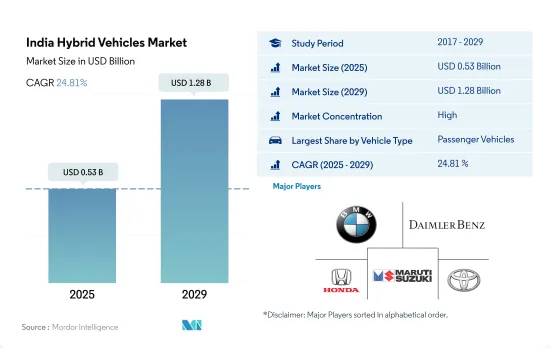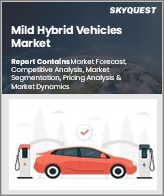
|
시장보고서
상품코드
1693634
인도의 하이브리드 차량 시장 : 시장 점유율 분석, 산업 동향 및 통계, 성장 예측(2025-2030년)India Hybrid Vehicles - Market Share Analysis, Industry Trends & Statistics, Growth Forecasts (2025 - 2030) |
||||||
인도의 하이브리드 차량(HEV) 시장 규모는 2025년에는 5억 3,000만 달러로 추정되고, 2029년에는 12억 8,000만 달러에 이를 것으로 예측되며, 예측 기간 중(2025-2029년) CAGR은 24.81%를 나타낼 것으로 예측됩니다.

하이브리드 차량은 인도가 완전한 전기 모빌리티로 전환하는 과정에서 가교 역할을 하며 인도의 점진적인 전기화 단계를 보여줍니다.
- 인도의 하이브리드 차량 시장은 순수 전기자동차 시장만큼 방대하지는 않지만 승용차, 상용차, 이륜차 등 다양한 차량 부문에서 연비와 배기가스 배출 감소라는 광범위한 목표를 달성하는 데 중요한 디딤돌이 되고 있습니다. 내연기관과 전기 모터를 모두 사용할 수 있는 완전 하이브리드는 플러그를 꽂을 필요 없이 기존 차량과 완전 전기차 사이의 실용적인 절충안을 제시하며, 기존 차량에 비해 향상된 연비와 낮은 배기가스 배출량을 제공합니다.
- 승용차 부문에서 완전 하이브리드 차량은 인도 소비자들 사이에서 주로 중고급 시장 부문을 중심으로 점차 인기를 얻고 있습니다. 인도에서 하이브리드 자동차의 매력은 순수 전기차와 관련된 주행거리 불안이나 인프라 수요 없이 연비를 크게 개선하고 운영 비용을 절감할 수 있다는 데 있습니다. 그러나 승용차 부문에서 하이브리드 자동차의 성장은 초기 구매 가격이 높고 모델 선택의 폭이 제한되어 다소 제약이 있었지만, 더 많은 제조업체가 시장에 진입하고 기술 비용이 감소하면서 변화가 시작되고 있습니다.
- 인도의 상용차 부문은 환경 문제와 연비가 점점 더 중요해지고 있는 부문에서 하이브리드 기술에 대한 관심이 제한적이지만 증가하고 있습니다.
인도의 하이브리드 차량 시장 동향
인도의 자동차 이자율은 인도중앙은행의 조치와 진화하는 대출 관행에 힘입어 지속적으로 하락하는 추세를 보이고 있습니다.
- 최근 인도의 자동차 이자율은 약 8.567%로, 2021년 8.698%에서 하락세를 보이고 있습니다. 약 1.5%의 소폭 하락은 2019년 9.15%에서 2021년 8.698%로 하락한 전년도의 추세를 이어가는 것입니다. 이러한 역학 관계를 뒷받침하는 요인으로는 인도 중앙은행(RBI)의 통화 정책 결정, 국내 신용 수요, 더 광범위한 거시 경제 상황을 들 수 있습니다.
- 2017-2023년 동안 인도의 자동차 이자율은 9.508%로 관측되었습니다. 이후 몇 년 동안 이자율은 소폭의 변동을 보였으며, 2018년에는 9.454%로 소폭 하락했다가 2019년에는 9.466%로 소폭 상승했습니다. 그러나 2019년부터는 더 큰 폭으로 하락하여 2022년에는 8.567%로 정점을 찍었습니다.
- 최근 인도 자동차 금리에 대한 추세 분석에 따르면 향후 몇 년간 상대적으로 낮은 금리가 지속될 것으로 예상됩니다. 2019년 9.15%에서 2022년 8.567%로 하락한 현재 금리는 경제 성장을 촉진하려는 인도중앙은행(RBI)의 의도적인 노력을 반영한 것입니다.
정부의 노력과 엄격한 규범은 인도 전기자동차 시장의 급성장을 견인
- 인도의 전기자동차(EV) 시장은 성장 단계에 있으며, 정부는 환경 오염을 막기 위한 전략을 적극적으로 수립하고 있습니다. 2015년에 시작된 페임 인디아 제도는 차량 전기화를 촉진하는 데 중추적인 역할을 해왔습니다.
- 인도 전역의 주 정부는 내연기관(ICE) 버스에서 전기 버스로 전환하기 위해 점점 더 많은 전기 버스를 차량에 도입하고 있습니다. 이러한 움직임은 운영 비용을 절감할 뿐만 아니라 탄소 배출을 억제하고 대기 질을 개선하는 효과도 있습니다. 주목할 만한 움직임으로 델리 정부는 2021년 3월에 300대의 새로운 저상 전기(AC) 버스 조달을 승인했으며, 이 중 100대는 2022년 1월에 도로에 투입될 예정입니다.
- 최근 인도 정부의 엄격한 규범 도입으로 전기자동차에 대한 수요가 급증하고 있습니다. 2021년 8월, 인도 정부는 연식에 관계없이 공해를 유발하고 부적합한 차량을 단계적으로 퇴출하는 것을 목표로 하는 차량 폐기 정책을 발표했습니다. 2024년까지 시행될 예정인 이 정책은 소비자들이 전기자동차로 이동하도록 유도하고 있습니다. 또한 인도 정부는 2030년까지 인도 내 모든 자동차의 30%를 전기화한다는 야심찬 목표를 세웠습니다
인도의 하이브리드 차량 산업 개요
인도의 하이브리드 차량 시장은 상위 5개 기업이 100%를 점유하고 있는 상당히 통합된 시장입니다. 이 시장의 주요 업체는 BMW India Private Limited, Daimler AG (Mercedes-Benz AG), Honda Cars India Limited, Maruti Suzuki India Limited, Toyota Kirloskar Motor Pvt. Ltd. 등입니다.(알파벳 순 정렬)
기타 혜택
- 엑셀 형식 시장 예측(ME) 시트
- 3개월의 애널리스트 지원
목차
제1장 주요 요약과 주요 조사 결과
제2장 보고서 제안
제3장 소개
- 조사의 전제조건과 시장 정의
- 조사 범위
- 조사 방법
제4장 주요 산업 동향
- 인구
- 1인당 GDP
- 차량 구매를 위한 소비자 지출(CVP)
- 인플레이션율
- 자동차 대출 금리
- 공유 차량 서비스
- 전기화의 영향
- EV 충전소
- 배터리 팩 가격
- Xev 신모델 발표
- 물류실적지수
- 중고차 판매
- 연료 가격
- OEM 생산 통계
- 규제 틀
- 밸류체인과 유통채널 분석
제5장 시장 세분화
- 차량 부문
- 상용차
- 버스
- 대형 상용 트럭
- 경상용 픽업 트럭
- 경상용 밴
- 중형 상용 트럭
- 상용차
제6장 경쟁 구도
- 주요 전략 동향
- 시장 점유율 분석
- 기업 상황
- 기업 프로파일
- Audi Auto India Pvt. Ltd.
- BMW India Private Limited
- Daimler AG(Mercedes-Benz AG)
- Honda Cars India Limited
- 현대자동차 India Limited
- Maruti Suzuki India Limited
- Toyota Kirloskar Motor Pvt. Ltd.
- Volvo Auto India Private Limited
제7장 CEO에 대한 주요 전략적 질문
제8장 부록
- 세계 개요
- 개요
- Five Forces 분석 프레임워크
- 세계의 밸류체인 분석
- 시장 역학(DROs)
- 출처 및 참고문헌
- 도표 일람
- 주요 인사이트
- 데이터 팩
- 용어집
The India Hybrid Vehicles Market size is estimated at 0.53 billion USD in 2025, and is expected to reach 1.28 billion USD by 2029, growing at a CAGR of 24.81% during the forecast period (2025-2029).

Hybrid vehicles serve as a bridge in the country's shift to full electric mobility, marking India's incremental steps toward electrification
- The Indian hybrid vehicles market, though not as vast as that for purely electric vehicles, presents a critical stepping stone toward achieving broader goals of fuel efficiency and reduced emissions across different vehicle types, such as passenger cars, commercial vehicles, and two-wheelers. Full hybrids, which can operate on both an internal combustion engine and an electric motor without the need to be plugged in, offer a practical compromise between traditional and fully electric vehicles, providing enhanced fuel efficiency and lower emissions compared to conventional vehicles.
- In the passenger car segment, full hybrid vehicles are gradually gaining traction among Indian consumers, primarily in the mid to high-end market segments. The appeal of hybrid cars in India lies in their ability to offer significant improvements in fuel efficiency and reduced operational costs without the range anxiety or infrastructure demands associated with pure electric vehicles. However, the growth of HEVs in the passenger car segment has been somewhat constrained by higher initial purchase prices and a limited selection of models, although this is beginning to change as more manufacturers enter the market and technology costs decrease.
- The commercial vehicle segment in India has seen limited but growing interest in hybrid technology, particularly in sectors where environmental concerns and fuel efficiency are becoming increasingly important. Hybrid buses are a notable example, with several cities initiating trials or small-scale deployments of hybrid technology to reduce emissions and fuel consumption in public transportation.
India Hybrid Vehicles Market Trends
India's auto interest rates have shown a consistent downward trend, driven by RBI's measures and evolving lending practices
- In recent times, India's auto interest rate stood at approximately 8.567%, marking a decline from the 8.698% observed in 2021. This slight decrement of about 1.5% continues the trend from the prior year, wherein rates reduced from 9.15% in 2019 to 8.698% in 2021. Factors underpinning these dynamics may encompass monetary policy decisions by the Reserve Bank of India (RBI), domestic credit demand, and broader macroeconomic conditions.
- During 2017-2023, India's auto interest rate was observed at 9.508%. Over the subsequent years, the rate experienced minor fluctuations, descending slightly to 9.454% in 2018 and then marginally ascending to 9.466% in 2019. However, a more significant decline was observed from 2019 onwards, culminating at 8.567% in 2022. Reports from the RBI suggest that these shifts could be attributed to a combination of monetary easing measures, evolving lending practices, and attempts to bolster economic growth in the face of challenges such as the global pandemic.
- The recent trend analysis of India's auto interest rates anticipates a continued trend of relatively lower interest rates in the coming years. The current decrease to 8.567% in 2022, building on the decline from 9.15% in 2019, reflects a deliberate effort by the Reserve Bank of India (RBI) to stimulate economic growth. This downward pressure on rates is likely to persist as the RBI continues to employ monetary easing measures and lending practices evolve to support credit demand.
Government initiatives and stringent norms drive rapid growth in the electric vehicle market in India
- India's electric vehicle (EV) market is in a growth phase, with the government actively formulating strategies to combat pollution. The Fame India scheme, launched in 2015, has played a pivotal role in driving vehicle electrification. Building on its success, Fame Phase 2, active till April 2022, further bolstered EV sales, especially in 2021, with the government offering subsidies like INR 10,000 grants for electric cars with battery capacities up to 15 kWh.
- State governments across India are increasingly incorporating electric buses into their fleets, aiming to transition from internal combustion engine (ICE) buses. This move not only cuts operational costs but also curbs carbon emissions and improves air quality. In a notable move, the Delhi government greenlit the procurement of 300 new low-floor electric (AC) buses in March 2021, with 100 of them hitting the roads in January 2022. These initiatives contributed to a significant 62.58% surge in demand for electric commercial vehicles in India in 2022 over 2021.
- The demand for electric cars has surged in recent times, driven by the government's introduction of stringent norms. In August 2021, the Indian government unveiled the Vehicle Scrappage Policy, targeting the phasing out of polluting and unfit vehicles, irrespective of their age. This policy, set to be implemented by 2024, is steering consumers toward electric cars. Additionally, the government has set an ambitious target of having 30% of all cars in India electrified by 2030. These initiatives are poised to propel electric car sales during the 2024-2030 period in India.
India Hybrid Vehicles Industry Overview
The India Hybrid Vehicles Market is fairly consolidated, with the top five companies occupying 100%. The major players in this market are BMW India Private Limited, Daimler AG (Mercedes-Benz AG), Honda Cars India Limited, Maruti Suzuki India Limited and Toyota Kirloskar Motor Pvt. Ltd. (sorted alphabetically).
Additional Benefits:
- The market estimate (ME) sheet in Excel format
- 3 months of analyst support
TABLE OF CONTENTS
1 EXECUTIVE SUMMARY & KEY FINDINGS
2 REPORT OFFERS
3 INTRODUCTION
- 3.1 Study Assumptions & Market Definition
- 3.2 Scope of the Study
- 3.3 Research Methodology
4 KEY INDUSTRY TRENDS
- 4.1 Population
- 4.2 GDP Per Capita
- 4.3 Consumer Spending For Vehicle Purchase (cvp)
- 4.4 Inflation
- 4.5 Interest Rate For Auto Loans
- 4.6 Shared Rides
- 4.7 Impact Of Electrification
- 4.8 EV Charging Station
- 4.9 Battery Pack Price
- 4.10 New Xev Models Announced
- 4.11 Logistics Performance Index
- 4.12 Used Car Sales
- 4.13 Fuel Price
- 4.14 Oem-wise Production Statistics
- 4.15 Regulatory Framework
- 4.16 Value Chain & Distribution Channel Analysis
5 MARKET SEGMENTATION (includes market size in Value in USD and Volume, Forecasts up to 2029 and analysis of growth prospects)
- 5.1 Vehicle Type
- 5.1.1 Commercial Vehicles
- 5.1.1.1 Buses
- 5.1.1.2 Heavy-duty Commercial Trucks
- 5.1.1.3 Light Commercial Pick-up Trucks
- 5.1.1.4 Light Commercial Vans
- 5.1.1.5 Medium-duty Commercial Trucks
- 5.1.1 Commercial Vehicles
6 COMPETITIVE LANDSCAPE
- 6.1 Key Strategic Moves
- 6.2 Market Share Analysis
- 6.3 Company Landscape
- 6.4 Company Profiles
- 6.4.1 Audi Auto India Pvt. Ltd.
- 6.4.2 BMW India Private Limited
- 6.4.3 Daimler AG (Mercedes-Benz AG)
- 6.4.4 Honda Cars India Limited
- 6.4.5 Hyundai Motor India Limited
- 6.4.6 Maruti Suzuki India Limited
- 6.4.7 Toyota Kirloskar Motor Pvt. Ltd.
- 6.4.8 Volvo Auto India Private Limited
7 KEY STRATEGIC QUESTIONS FOR VEHICLES CEOS
8 APPENDIX
- 8.1 Global Overview
- 8.1.1 Overview
- 8.1.2 Porter's Five Forces Framework
- 8.1.3 Global Value Chain Analysis
- 8.1.4 Market Dynamics (DROs)
- 8.2 Sources & References
- 8.3 List of Tables & Figures
- 8.4 Primary Insights
- 8.5 Data Pack
- 8.6 Glossary of Terms



















